Elliot Formation
| Elliot Formation | |
|---|---|
| Stratigraphic range: Norian-Pliensbachian ~ | |
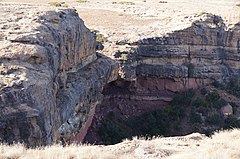 Elliot Formation caves in the Matalane Valley, Leribe, Lesotho | |
| Type | Geological formation |
| Unit of | Stormberg Group |
| Sub-units | Upper Elliot, Lower Elliot |
| Underlies | Clarens Formation |
| Overlies | Molteno Formation |
| Thickness | up to 500 m (1,600 ft) |
| Lithology | |
| Primary | Mudstone, sandstone |
| Other | Siltstone, conglomerate |
| Location | |
| Coordinates | 30°30′S 27°24′E / 30.5°S 27.4°E |
| Approximate paleocoordinates | 44°06′S 1°54′W / 44.1°S 1.9°W |
| Region | Eastern Cape, Free State, Mafeteng, Maseru, Quthing, Qacha's Nek & Mohale's Hoek |
| Country | |
| Type section | |
| Named for | Elliot, Eastern Cape |
The Elliot Formation is a geological formation and forms part of the Stormberg Group, the uppermost geological group that comprises the greater Karoo Supergroup. Outcrops of the Elliot Formation have been found in the northern Eastern Cape, southern Free State, and in the eastern KwaZulu-Natal provinces of South Africa. Outcrops and exposures are also found in several localities in Lesotho such as Qacha's Neck, Hill Top, Quthing, and near the capital, Maseru. The Elliot Formation is further divided into the lower (LEF) and upper (UEF) Elliot formations to differentiate significant sedimentological differences between these layers. The LEF is dominantly Late Triassic (Norian-Hettangian) in age while the UEF is mainly Early Jurassic (Sinemurian-Pliensbachian) and is tentatively regarded to preserve a continental record of the Triassic-Jurassic boundary in southern Africa.[1] This geological formation is named after the town of Elliot in the Eastern Cape, and its stratotype locality is located on the Barkly Pass, 9 km north of the town.[2][3][4]
Geology
[edit]The Elliot Formation unconformably overlies the Molteno Formation and is conformably overlain by the Clarens Formation. Due to the reddish colour of the rocks, the Elliot Formation is colloquially referred to as the “Red Beds” in older geologic literature.
The Elliot Formation is dominated by mudstones and siltstones that can be finely laminated. However, the internal structures in the mudstones are often not visible due to locally poor laminations. Calcareous nodules are also found in the mudstone layers and become more frequent up section into the UEF. The mudstones range in colour from greyish purple red in the LEF and turn a more brick red colour with more mature palaeosols in the UEF. Localized intraformational pebble conglomerates that comprise intrabasinal clasts that comprise mud chips, quartzite pebbles, pedogenic nodules, and fossil bone fragments only occur in the UEF. The lower and upper Elliot formations both contain sandstones but they vary in their internal geometries. The sandstones of the LEF mainly comprise laterally accreting channel deposits that are multi-story and contain trough, low angle, and planar, cross-bedding. Ripple cross laminations with good horizontal lamination are also present. In the UEF, sandstone beds are single story and mainly reflect downstream accretion channel geometries and are more tabular in appearance. Common internal sedimentary structures of UEF sandstones are planar, low angle cross-bedding, horizontal and ripple-cross laminations.
The LEF was deposited in a fluvio-lacustrine environment where rivers were more perennial and formed meandering channel geometries, as evidenced by the presence of lateral accretion. However, this depositional environment changed at the onset of the UEF deposits where evidence of shallower river channels, longer periods of floodplain stasis (mature palaeosols) and flash flood events (pedogenic nodule conglomerates) shows that the climate became more arid.[5][6][7][8]
Correlation
[edit]The Elliot Formation is currently considered to correlate chronostratigraphically with geological formations of the Bodibeng Sandstone of the Tuli Basin in Botswana, the Omingonde Formation of the Etjo Basin in Namibia, and the Chinle Formation of the Colorado Plateau in Utah, United States.[9][10][11][12][13][14]
Paleontology
[edit]The Elliot Formation is well known for its diverse dinosaur fossils. The most common dinosaur species is of the sauropodomorph species Massospondylus carinatus.[15][16] Other species include Blikanasaurus cromptoni, Aardonyx celestae, Euskelosaurus browni, Antetonitrus ingenipes, Pulanesaura eocollum, and the largest sauropodomorph yet found, Ledumahadi mafube.[17][18][19][20][21][22][23][24] Fossilised Massospondylus eggs, some with the fossilized remains of embryos intact, have been recovered from UEF deposits in the Golden Gate Highlands National Park.[25][26] Euskelosaurus fossils are more common in the LEF while Massospondylus are only found in the UEF. The basal ornithischian dinosaurs, Heterodontosaurus tucki, Lesothosaurus diagnosticus, Abrictosaurus consors, and Lycorhinus angustidens have also been recovered from the UEF.[27][28] In addition this formation has yielded various crocodylomorph species,[29] namely Litargosuchus leptorhynchus, Sphenosuchus acutus and Orthosuchus stormbergi.[30][31][32][33] A large theropod dinosaur, Dracovenator regenti, has been found in the UEF.[34] Synapsids from the formation include the dicynodont Pentasaurus goggai[35] the tritheledontid cynodont Elliotherium kersteni[36][37] and the mammaliaform Megazostrodon rudnerae.[38] More recent vertebrate fossil finds near the town Qhemegha in the Eastern Cape have yielded possible fossil material of a poposauroid pseudosuchian. The mudstones of the LEF sometimes yield petrified wood, fossil plant matter, crustaceans, fishes, and turtles while the sandstones of the upper Elliot Formation more often contain various trace fossils. These include vertebrate trackways of basal ornithischian dinosaurs found in the Leribe, Mafeteng, and Mohales Hoek Districts of Lesotho. Possible trackways of the dicynodont Pentasaurus have been found on Morobong Hill in the Mohales Hoek District of Lesotho.[39][40][41][42]
Dinosaurs
[edit]Color key
|
Notes Uncertain or tentative taxa are in small text; |
Ornithischians
[edit]| Ornithischians of the Elliot Formation | |||||
|---|---|---|---|---|---|
| Genus | Species | Location | Stratigraphy | Notes | Images |
| Abrictosaurus | A. consors |
|
A heterodontosaurid, formerly species of Lycorhinus | 
| |
| Eocursor | E. parvus |
|
A basal ornithischian | 
| |
| Fabrosaurus | F. australis |
|
A basal ornithischian, nomen dubium | ||
| Heterodontosaurus | H. tucki |
|
A heterodontosaurid | 
| |
| Lesothosaurus | L. diagnosticus |
|
A basal neornithischian or thyreophoran, formerly species of Fabrosaurus | 
| |
| Lycorhinus | L. angustidens |
|
A heterodontosaurid | ||
| Pegomastax | P. africana |
|
A heterodontosaurid | 
| |
Sauropodomorphs
[edit]| Sauropodomorphs of the Elliot Formation | |||||
|---|---|---|---|---|---|
| Genus | Species | Location | Stratigraphy | Notes | Images |
| Aardonyx | A. celestae |
|
A derived sauropodomorph | 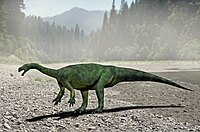
| |
| Antetonitrus | A. ingenipes |
|
A derived sauropodomorph or basal sauropod | 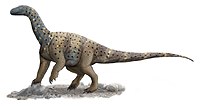
| |
| Arcusaurus | A. pereirabdalorum |
|
|
A basal sauropodomorph, known from juveniles |  |
| Blikanasaurus | B. cromptoni |
|
|
A derived sauropodomorph or basal sauropod | |
| Eucnemesaurus | E. fortis |
|
A possible riojasaurid | ||
| E. entaxonis | |||||
| Euskelosaurus | E. browni |
|
A plateosaurid, potentially dubious | ||
| Gryponyx | G. africanus |
|
A massospondylid, potentially dubious | ||
| Ignavusaurus | I. rachelis |
|
A massospondylid, known from a juvenile, potential synonym of Massospondylus | ||
| Kholumolumo | K. ellenbergerorum |
|
A basal sauropodiform | ||
| Ledumahadi | L. mafube | A derived sauropodomorph or basal sauropod, largest in the formation | 
| ||
| Massospondylus | M. carinatus |
|
A massospondylid, most common fossil found | 
| |
| M. kaalae |
|
A massospondylid, differs from M. carinatus in cranial features | |||
| Melanorosaurus | M. readi |
|
|
A derived sauropodomorph | 
|
| Meroktenos | M. thabanensis |
|
|
A derived sauropodomorph, formerly a species of Melanorosaurus | 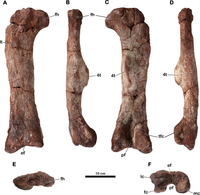 |
| Plateosauravus | P. cullingworthi |
|
A basal sauropodomorph, formerly specimens of Euskelosaurus | ||
| Pulanesaura | P. eocollum |
|
A derived sauropodomorph or basal sauropod | 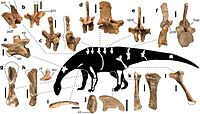 | |
| Sefapanosaurus | S. zastronensis |
|
A derived sauropodomorph | ||
Theropods
[edit]| Theropods of the Elliot Formation | |||||
|---|---|---|---|---|---|
| Genus | Species | Location | Stratigraphy | Notes | Images |
| Dracovenator | D. regenti |
|
|
A dilophosaurid | 
|
| Megapnosaurus | M. rhodesiensis |
|
|
A coelophysid | 
|
Suchians
[edit]Crocodylomorphs
[edit]| Crocodylomorphs of the Elliot Formation | ||||||
|---|---|---|---|---|---|---|
| Genus | Species | Location | Stratigraphy | Notes | Images | |
| Basutodon | B. ferox |
|
A dubious suchian | |||
| Litargosuchus | L. leptorhynchus |
|
|
A basal crocodylomorph | 
| |
| Orthosuchus | O. stormbergi |
|
A possible protosuchid | |||
| Rauisuchian |
|
A indeterminate large "Rauisuchian" | ||||
| Sphenosuchus | S. acutus |
|
A large basal crocodylomorph | |||
Synapsids
[edit]| Synapsids of the Elliot Formation | ||||||
|---|---|---|---|---|---|---|
| Genus | Species | Location | Stratigraphy | Notes | Images | |
| Elliotherium | E. kersteni |
|
A tritheledontid cynodont | |||
| Megazostrodon | M. rudnerae |
|
A megazostrodontid cynodont | 
| ||
| Pentasaurus | P. goggai |
|
A stahleckeriid dicynodont | |||
| Scalenodontoides | S. macrodontes |
|
A very large traversodontid cynodont | |||
References
[edit]- ^ Bordy, Emese M.; Abrahams, Miengah; Sharman, Glenn R.; Viglietti, Pia A.; Benson, Roger B.J.; McPhee, Blair W.; Barrett, Paul M.; Sciscio, Lara; Condon, Daniel; Mundil, Roland; Rademan, Zandri (April 2020). "A chronostratigraphic framework for the upper Stormberg Group: Implications for the Triassic-Jurassic boundary in southern Africa". Earth-Science Reviews. 203: 103120. Bibcode:2020ESRv..20303120B. doi:10.1016/j.earscirev.2020.103120. ISSN 0012-8252. S2CID 213646670.
- ^ Bordy, Emese M.; John Hancox, P.; Rubidge, Bruce S. (2004-03-01). "Fluvial style variations in the Late Triassic–Early Jurassic Elliot formation, main Karoo Basin, South Africa". Journal of African Earth Sciences. 38 (4): 383–400. Bibcode:2004JAfES..38..383B. doi:10.1016/j.jafrearsci.2004.02.004. ISSN 1464-343X.
- ^ "A description of the sedimentology and palaeontology of the Late Triassic–Early Jurassic Elliot Formation in Lesotho". WIReDSpace Wits. 2004-09-01. ISSN 0078-8554.
- ^ Bordy, E.M.; Eriksson, P. (2015-09-01). "Lithostratigraphy of the Elliot Formation (Karoo Supergroup), South Africa". South African Journal of Geology. 118 (3): 311–316. Bibcode:2015SAJG..118..311B. doi:10.2113/gssajg.118.3.311. hdl:2263/55739. ISSN 1012-0750.
- ^ Tankard, Anthony; Welsink, Herman; Aukes, Peter; Newton, Robert; Stettler, Edgar (2009-09-01). "Tectonic evolution of the Cape and Karoo basins of South Africa". Marine and Petroleum Geology. 26 (8): 1379–1412. Bibcode:2009MarPG..26.1379T. doi:10.1016/j.marpetgeo.2009.01.022. ISSN 0264-8172.
- ^ "Meander channel, point bar, crevasse splay and aeolian deposits from the Elliot Formation in Barkly Pass, North-eastern Cape". South African Journal of Geology. 83 (1). 1980-01-01. ISSN 1012-0750.
- ^ Bordy, E.M.; Eriksson, P. (2015-09-01). "Lithostratigraphy of the Elliot Formation (Karoo Supergroup), South Africa". South African Journal of Geology. 118 (3): 311–316. Bibcode:2015SAJG..118..311B. doi:10.2113/gssajg.118.3.311. hdl:2263/55739. ISSN 1012-0750.
- ^ Sciscio, Lara; De Kock, Michiel; Bordy, Emese; Knoll, Fabien (2017-11-01). "Magnetostratigraphy across the Triassic-Jurassic boundary in the main Karoo Basin". Gondwana Research. 51: 177–192. Bibcode:2017GondR..51..177S. doi:10.1016/j.gr.2017.07.009. hdl:10261/338607. ISSN 1342-937X.
- ^ Attridge, J.; Crompton, A. W.; Jenkins, Farish A. (June 1985). "The Southern African Liassic prosauropodMassospondylusdiscovered in North America". Journal of Vertebrate Paleontology. 5 (2): 128–132. Bibcode:1985JVPal...5..128A. doi:10.1080/02724634.1985.10011850. ISSN 0272-4634.
- ^ Eriksson, P.; Bordy, E. M. (September 2015). "Lithostratigraphy of the Elliot Formation (Karoo Supergroup), South Africa". South African Journal of Geology. 118 (3): 311–316. Bibcode:2015SAJG..118..311B. doi:10.2113/gssajg.118.3.311. hdl:2263/55739. ISSN 1012-0750.
- ^ Smith, R. M.H.; Swart, R. (2002-06-01). "Changing Fluvial Environments and Vertebrate Taphonomy in Response to Climatic Drying in a Mid-Triassic Rift Valley Fill: The Omingonde Formation (Karoo Supergroup) of Central Namibia". PALAIOS. 17 (3): 249–267. Bibcode:2002Palai..17..249S. doi:10.1669/0883-1351(2002)017<0249:CFEAVT>2.0.CO;2. ISSN 0883-1351. S2CID 130316395.
- ^ Abdala, Fernando; Smith, Roger M. H. (2009-09-12). "A Middle Triassic cynodont fauna from Namibia and its implications for the biogeography of Gondwana". Journal of Vertebrate Paleontology. 29 (3): 837–851. Bibcode:2009JVPal..29..837A. doi:10.1671/039.029.0303. ISSN 0272-4634. S2CID 129096876.
- ^ Walker, A. D. (1990-10-29). "A revision of Sphenosuchus acutus Haughton, a crocodylomorph reptile from the Elliot Formation (late Triassic or early Jurassic) of South Africa". Phil. Trans. R. Soc. Lond. B. 330 (1256): 1–120. doi:10.1098/rstb.1990.0185. ISSN 0962-8436.
- ^ Tucker, Maurice E.; Benton, Michael J. (1982-12-01). "Triassic environments, climates and reptile evolution". Palaeogeography, Palaeoclimatology, Palaeoecology. 40 (4): 361–379. Bibcode:1982PPP....40..361T. doi:10.1016/0031-0182(82)90034-7. ISSN 0031-0182.
- ^ Sues, H.D., Reisz, R.R., Hinic, S. and Raath, M.A., 2004. On the skull of Massospondylus carinatus Owen, 1854 (Dinosauria: Sauropodomorpha) from the Elliot and Clarens formations (Lower Jurassic) of South Africa. Annals of Carnegie Museum, 73(4), pp.239–257.
- ^ Chinsamy, Anusuya. "Bone histology and growth trajectory of the prosauropod dinosaur Massospondylus carinatus Owen | Request PDF". ResearchGate. Retrieved 2018-11-14.
- ^ Galton, Peter M.; Heerden, Jacques (April 1998). "Anatomy of the prosauropod dinosaurBlikanasaurus cromptoni (Upper Triassic, South Africa), with notes on the other tetrapods from the lower Elliot Formation". Paläontologische Zeitschrift. 72 (1–2): 163–177. Bibcode:1998PalZ...72..163G. doi:10.1007/bf02987824. ISSN 0031-0220. S2CID 128464155.
- ^ Yates, Adam M. (2003). "A definite prosauropod dinosaur from the Lower Elliot Formation (Norian: Upper Triassic) of South Africa". Palaeontologia Africana. ISSN 0078-8554.
- ^ Barrett, Paul M. (2004-09-01). "Sauropodomorph dinosaur diversity in the upper Elliot Formation (Massospondylus range zone: Lower Jurassic) of South Africa: research letter". South African Journal of Science. 100 (9–10). ISSN 0038-2353.
- ^ McPhee, Blair; Bordy, Emese; Sciscio, Lara; Choiniere, Jonah (2017). "The sauropodomorph biostratigraphy of the Elliot Formation of southern Africa: Tracking the evolution of Sauropodomorpha across the Triassic–Jurassic boundary". Acta Palaeontologica Polonica. 62 (3). doi:10.4202/app.00377.2017. ISSN 0567-7920.
- ^ Hancox, P. John; Rubidge, Bruce S.; Yates, Adam M. (1 September 2004). "First record of a sauropod dinosaur from the upper Elliot Formation (Early Jurassic) of South Africa: research letter". South African Journal of Science. 100 (9): 504–506.
- ^ McPhee, Blair W.; Yates, Adam M.; Choiniere, Jonah N.; Abdala, Fernando (2014-04-25). "The complete anatomy and phylogenetic relationships of Antetonitrus ingenipes (Sauropodiformes, Dinosauria): implications for the origins of Sauropoda". Zoological Journal of the Linnean Society. 171 (1). doi:10.1111/zoj12127. ISSN 1096-3642.
- ^ McPhee, B. W.; Benson RBJ; Botha-Brink, J.; Bordy, E. M.; Choiniere, J. N. (2018-10-08). "A Giant Dinosaur from the Earliest Jurassic of South Africa and the Transition to Quadrupedality in Early Sauropodomorphs". Current Biology. 28 (19): 3143–3151.e7. Bibcode:2018CBio...28E3143M. doi:10.1016/j.cub.2018.07.063. ISSN 0960-9822. PMID 30270189.
- ^ Sander, P. M.; Lallensack, J. N. (2018-10-08). "Dinosaurs: Four Legs Good, Two Legs Bad". Current Biology. 28 (19): R1160–R1163. Bibcode:2018CBio...28R1160S. doi:10.1016/j.cub.2018.08.025. ISSN 0960-9822. PMID 30300605.
- ^ Kitching, James (1979). "Preliminary report on a clutch of six dinosaurian eggs from the Upper Triassic Elliot Formation, Northern Orange Free State". Palaeontologia Africana. 22: 41–45.
- ^ Reisz, Robert R.; Evans, David C.; Sues, Hans-Dieter; Scott, Diane (2010-12-02). "Embryonic skeletal anatomy of the sauropodomorph dinosaurMassospondylusfrom the Lower Jurassic of South Africa". Journal of Vertebrate Paleontology. 30 (6): 1653–1665. Bibcode:2010JVPal..30.1653R. doi:10.1080/02724634.2010.521604. ISSN 0272-4634. S2CID 84599991.
- ^ Knoll, Fabien (2002-07-08). "Nearly complete skull ofLesothosaurus(Dinosauria: Ornithischia) from the Upper Elliot Formation (Lower Jurassic: Hettangian) of Lesotho". Journal of Vertebrate Paleontology. 22 (2): 238–243. doi:10.1671/0272-4634(2002)022[0238:ncsold]2.0.co;2. ISSN 0272-4634. S2CID 85790601.
- ^ Butler, Richard J. (October 2005). "The 'fabrosaurid' ornithischian dinosaurs of the Upper Elliot Formation (Lower Jurassic) of South Africa and Lesotho". Zoological Journal of the Linnean Society. 145 (2): 175–218. doi:10.1111/j.1096-3642.2005.00182.x. ISSN 1096-3642.
- ^ Clark, James M.; Sues, Hans-Dieter (2002-08-21). "Two new basal crocodylomorph archosaurs from the Lower Jurassic and the monophyly of the Sphenosuchia". Zoological Journal of the Linnean Society. 136 (1): 77–95. doi:10.1046/j.1096-3642.2002.00026.x. ISSN 1096-3642.
- ^ Walker, A. D. (1990-10-29). "A revision of Sphenosuchus acutus Haughton, a crocodylomorph reptile from the Elliot Formation (late Triassic or early Jurassic) of South Africa". Phil. Trans. R. Soc. Lond. B. 330 (1256): 1–120. doi:10.1098/rstb.1990.0185. ISSN 0962-8436.
- ^ Nash, Diane (2009-08-20). "A crocodile from the Upper Triassic of Lesotho". Journal of Zoology. 156 (2): 163–179. doi:10.1111/j.1469-7998.1968.tb05927.x. ISSN 0952-8369.
- ^ Nash, D.S., 1975. The morphology and relationships of a crocodilian, Orthosuchus stormbergi, from the Upper Triassic of Lesotho. South African Museum.
- ^ Dollman, K. N.; Viglietti, P. A.; Choiniere, J. N. (2017-10-12). "A new specimen of Orthosuchus stormbergi (Nash 1968) and a review of the distribution of Southern African Lower Jurassic crocodylomorphs". Historical Biology. 31 (5): 653–664. doi:10.1080/08912963.2017.1387110. ISSN 0891-2963. S2CID 134134524.
- ^ "A new theropod dinosaur from the Early Jurassic of South Africa and its implication for the early evolution of theropods | Request PDF". ResearchGate. Retrieved 2018-11-16.
- ^ F., Kammerer, Christian (2018). "The first skeletal evidence of a dicynodont from the lower Elliot Formation of South Africa". Palaeontologia Africana. ISSN 2410-4418.
{{cite journal}}: CS1 maint: multiple names: authors list (link) - ^ Hancox, P. J.; Sidor, C. A. (March 2006). "Elliotherium Kersteni, A New Tritheledontid from the Lower Elliot Formation (Upper Triassic) of South Africa". Journal of Paleontology. 80 (2): 333–342. CiteSeerX 10.1.1.557.9156. doi:10.1666/0022-3360(2006)080[0333:EKANTF]2.0.CO;2. ISSN 0022-3360. S2CID 130003909.
- ^ Fernando, Abdala; Ross, Damiani; Adam, Yates; Johann, Neveling (2007). "A non-mammaliaform cynodont from the Upper Triassic of South Africa: a therapsid Lazarus taxon?". Palaeontologia Africana. ISSN 0078-8554.
- ^ E, Gow, Chris (1986-06-30). "A new skull of Megazostrodon (Mammalia, Triconodonta) from the Elliot Formation (Lower Jurassic) of Southern Africa". Palaeontologia Africana. ISSN 0078-8554.
{{cite journal}}: CS1 maint: multiple names: authors list (link) - ^ Anderson, J.M.; Anderson, H.M.; Cruickshank, A.R.I. (1998). "Late Triassic ecosystems of the Molteno Lower Elliot biome of southern Africa" (PDF). Palaeontology. 41 (3): 387–421.
- ^ Smith, R.; Kitching, J. (1997-06-01). "Sedimentology and vertebrate taphonomy of the Tritylodon Acme Zone: a reworked palaeosol in the Lower Jurassic Elliot Formation, Karoo Supergroup, South Africa". Palaeogeography, Palaeoclimatology, Palaeoecology. 131 (1–2): 29–50. Bibcode:1997PPP...131...29S. doi:10.1016/S0031-0182(96)00143-5. ISSN 0031-0182.
- ^ Knoll, Fabien (January 2005). "The tetrapod fauna of the Upper Elliot and Clarens formations in the main Karoo Basin (South Africa and Lesotho)". Bulletin de la Société Géologique de France. 176 (1): 81–91. doi:10.2113/176.1.81. ISSN 0037-9409.
- ^ Sciscio, Lara (December 2015). Position of the Triassic-Jurassic boundary in South Africa and Lesotho: a multidisciplinary approach aimed at improving the chronostratigraphy and biostratigraphy of the Elliot Formation, Stormberg Group (Thesis). University of Cape Town – via OpenUCT.
- Geologic formations of Lesotho
- Geologic formations of South Africa
- Stormberg Group
- Jurassic System of Africa
- Early Jurassic Africa
- Triassic System of Africa
- Late Triassic Africa
- Jurassic South Africa
- Triassic South Africa
- Norian Stage
- Rhaetian Stage
- Hettangian Stage
- Limestone formations
- Sandstone formations
- Mudstone formations
- Paleontology in Lesotho
- Paleontology in South Africa
- Karoo
- Geography of the Eastern Cape
- Geography of the Free State (province)
- Mafeteng District
- Maseru District
- Quthing District

